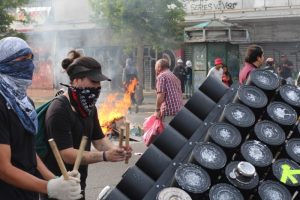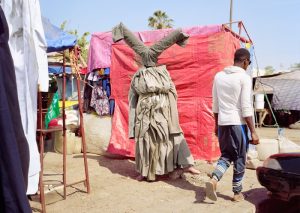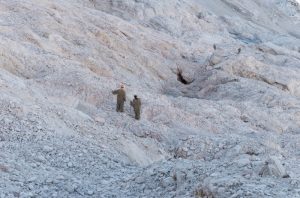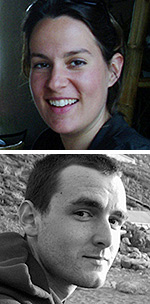 While at SIGGRAPH this September, I had the chance to visit MIT Media Lab a couple of times and stick my head into the labs of the different groups. At the time, the people in John Maeda‘s Physical Language Workshop were developing something exciting about art and commerce called OPENSTUDIO. At the time it was still closed but since it has recently been opened to the public, it is high time to find out more. Two of the group’s current researchers who also worked on the system, Amber Frid-Jimenez and Brent Fitzgerald, are happy to explain.
While at SIGGRAPH this September, I had the chance to visit MIT Media Lab a couple of times and stick my head into the labs of the different groups. At the time, the people in John Maeda‘s Physical Language Workshop were developing something exciting about art and commerce called OPENSTUDIO. At the time it was still closed but since it has recently been opened to the public, it is high time to find out more. Two of the group’s current researchers who also worked on the system, Amber Frid-Jimenez and Brent Fitzgerald, are happy to explain.
And – if you find this any interesting, you should also check out PLW-graduate Burak Arikan‘s (whose name will appear a few times more) latest project A Stock Market In Life as well!
Amber and Brent, could you sketch out what this project is all about in just a few words?
Brent: OPENSTUDIO is web + art + community + economics. It is an open-ended experiment that couples a very simple drawing tool with an economy of artists, curators, collectors, dealers and viewers. Members can create and modify drawings, set prices and licenses, exchange and exhibit work, view financial records, and commission one another. It is a conceptual foundation from which we’re continuing to develop further work in creative tools, collaboration, licenses, participatory media, law, and trust.
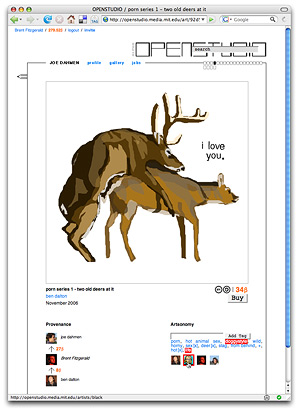 How does the system work practically? As I understand, I create an account, start to draw, of course end up with a mind-boggling masterpiece, and then what happens to it?
How does the system work practically? As I understand, I create an account, start to draw, of course end up with a mind-boggling masterpiece, and then what happens to it?
Amber: Your new drawing is saved into your private inventory, which you can access from the browser. From there, you can set a price for your drawing and put it in your public gallery. Once your drawing becomes public, it is automatically displayed on the OPENSTUDIO home page. This gives the community a chance to see and hopefully buy the new work. The latest transactions are also displayed on the home page, so anyone can see at a glance what the community is buying.
Brent: You create your account and you get 25 Buraks to start. It isn’t a lot of money, but it is enough to buy a few pieces, or you can save it and just start drawing, which is free. Whether you create your own piece or purchase from someone else, you can then choose a price, maybe tweak the license, and suddenly you are in the art business. As Amber mentioned, it turned out that the instant front page publishing was key. If your new drawing isn’t attractive for the asking price, it will languish there until you take it off the market or lower the price. We also allow negative prices, so if you make a real dog you can pay someone to take it off your hands.
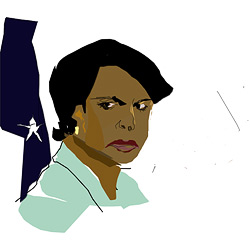 On the homepage it says that Openstudio is an “Experiment in Creativity, Collaboration and Capitalism”. That is an interesting statement since the c-word (the latter) is rarely so openly used in conjunction with art. What is your current assessment of how the art world works and where is it flawed in your opinion?
On the homepage it says that Openstudio is an “Experiment in Creativity, Collaboration and Capitalism”. That is an interesting statement since the c-word (the latter) is rarely so openly used in conjunction with art. What is your current assessment of how the art world works and where is it flawed in your opinion?
Amber: OPENSTUDIO is not intended as a direct critique of the existing art world, although it does loosely mimic a ‘real’ economic system. In the physical realm, art dealers and galleries determine the value of most works of art. It is flat, so the community determines the value of the drawings. Over time people learn what sells and what doesn’t without institutional mediation. You can also build on the work of others. When you buy a piece of work, you can buy the right to use it as the basis for a new drawing. You can buy a piece and modify it and save it as your own. Each piece retains its history, which promotes collaboration in a way that is not necessarily encouraged in the physical art world. In this way, OS plays with formalizing the act of appropriation inherent in digital works of art.
Brent: We’ve been careful to design transparency into OPENSTUDIO’s economic and creative processes. For an outsider the traditional art market can be difficult to wholly observe, let alone penetrate. It offers an alternative model in which all business transactions are recorded and published publicly, and can even be subscribed to as an RSS feed. Similarly it also publishes the history of every document. Derivation and reappropriation are essential creative processes, yet are often controversial issues in traditional media. OPENSTUDIO legitimizes and encourages derivative works by clarifying their connections to the originals.
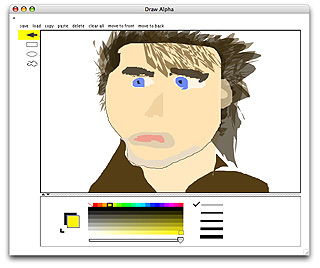 That’s an interesting point, since one could argue that a certain opacity is in integral part of the art world and is possibly also necessary in the act of concealing that art (almost) never falls from the sky but is the result of work, inspiration and also derivation as well as reappropriation. Have you already had feedback from professional artists about whether they appreciate such a radically different way of exhibiting and especially selling their work?
That’s an interesting point, since one could argue that a certain opacity is in integral part of the art world and is possibly also necessary in the act of concealing that art (almost) never falls from the sky but is the result of work, inspiration and also derivation as well as reappropriation. Have you already had feedback from professional artists about whether they appreciate such a radically different way of exhibiting and especially selling their work?
Brent: Target audience is an interesting issue. By virtue of using the web as our medium we open participation to a wide range of people. The web, and specifically a participatory system on the web, seems to tend towards a more populist model. We have received generally positive feedback from participating artists and designers, some well established in their careers, others in school or just starting out. Recently someone pointed out to me how important it is that we provide a “view source” link for each piece. Even though most artists don’t know what to do with this source, it hopefully gets them thinking about process, ownership and digital rights. How does the ethos of the open source movement extend the media and art industries? OPENSTUDIO is an environment in which we can try to address questions like this.
The openness of the system and especially the artworks’ individual history and traceability is a bit remindful of the kind of accountability in Wikis, even though the outcome is much less of a collaborative effort than a new piece in its own right. What were your main influences when designing the paradigms of the system? Did John Maeda’s experience as an artist play a role?
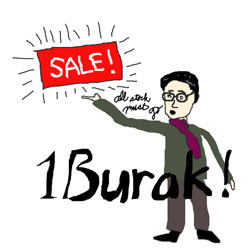 Brent: John’s work with Design By Numbers and computational design are of course influences on our work. Back in the old pre-wiki days he had a great class exercise in which one by one each student sat at the computer and modified a program, cumulatively producing a unique piece of creative code. John also became interested in business a few years back, even went and got his MBA, and in doing so he imported some of the vocabulary and paradigms from the business world into this research. Personally I’m fascinated with the economic and legal side of distributed, participatory communities like this. Right now I’m working on a socially enforced, procedurally executed contracting service, which I think originated in watching people buy, sell and commission one another on OPENSTUDIO. I’ve been influenced by open source projects, agile development, standards, web services, Lessig’s free culture stuff, O’Reilly’s architecture of participation, Anderson’s Long Tail, etc, of course all inevitably filtered through a Media Lab/Wired/McLuhanesque interest in enabling technologies.
Brent: John’s work with Design By Numbers and computational design are of course influences on our work. Back in the old pre-wiki days he had a great class exercise in which one by one each student sat at the computer and modified a program, cumulatively producing a unique piece of creative code. John also became interested in business a few years back, even went and got his MBA, and in doing so he imported some of the vocabulary and paradigms from the business world into this research. Personally I’m fascinated with the economic and legal side of distributed, participatory communities like this. Right now I’m working on a socially enforced, procedurally executed contracting service, which I think originated in watching people buy, sell and commission one another on OPENSTUDIO. I’ve been influenced by open source projects, agile development, standards, web services, Lessig’s free culture stuff, O’Reilly’s architecture of participation, Anderson’s Long Tail, etc, of course all inevitably filtered through a Media Lab/Wired/McLuhanesque interest in enabling technologies.
Let’s stick with the economic aspects a bit: You also work on something called OpenCode which is intended to be a platform where code-snipplets for Processing can be dealt in the same fashion as in OPENSTUDIO. Do you think such a micro-economy could be a viable alternative to today’s way of buying and using software or of certain commodities in general? How does this relate to the strictly non-commercial approaches in the open-source/knowledge universe?
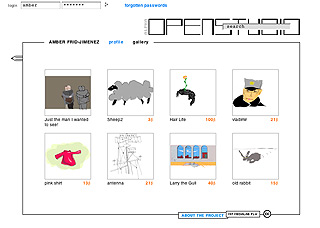 Amber: OpenCode is a project that Kyle Buza and Takashi Okamoto developed over the Summer and Fall. OpenCode is a natural extension of the ideas that we worked with in OS. Since Kyle sits next to me, I asked him to respond: OpenCode was originally designed to leverage the OPENSTUDIO economic model. Before completing the implementation, we began to be contacted by educators interested in using the system as a component of their courses. When used in this context, an economic infrastructure becomes less interesting. In addition, we began to feel that there was something less personal and revealing about the types of code purchased by an individual. We believe that these types of subtly revealing actions are what make OS interesting, and may not apply to the production of code.
Amber: OpenCode is a project that Kyle Buza and Takashi Okamoto developed over the Summer and Fall. OpenCode is a natural extension of the ideas that we worked with in OS. Since Kyle sits next to me, I asked him to respond: OpenCode was originally designed to leverage the OPENSTUDIO economic model. Before completing the implementation, we began to be contacted by educators interested in using the system as a component of their courses. When used in this context, an economic infrastructure becomes less interesting. In addition, we began to feel that there was something less personal and revealing about the types of code purchased by an individual. We believe that these types of subtly revealing actions are what make OS interesting, and may not apply to the production of code.
Brent: Though it has been a dominant theme with us this past year, we’re not dogmatic about including a microeconomy in everything we make. Fundamentally we’re interested in facilitating new models for collaborative and creative lives, and we’re open to a variety of approaches.
As I’ve been told, you plan to extend the OPEN-scheme to other areas as well. I’ve heard something of OpenBank, which would be quite a gigantic leap from the art/technology-world into the open of the ultimate networkedness of monetary exchange. Could you outline this project a bit and tell us what you think the expected benefits and consequences of transparent banking would be?
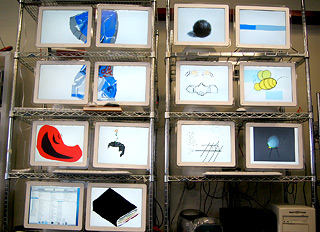 Brent: I started working on The Bank of Burak a few months back in an effort to factor out the financial component of OPENSTUDIO to create a standalone, quasi-official financial institution. Within this creative community space we’d like to facilitate more sophisticated financial interactions like auctions, market trading, personal IPOs, currency exchange, renting networked hardware like Pinkies, gifts and donations, and maybe others we’ve not considered. OPENSTUDIO’s built-in bank is simple and fun, and ok for what we’re doing now, but it isn’t flexible enough for all these different uses. We’re also certain that other researchers could come up with many other applications for this art currency, and to make that possible we’ll need a decent set of web services for transactions of Burak. There is still a bit of work to do, but when it comes together BofB will be an endpoint for all these transactions, sort of a community finance infoporn center with a rich API.
Brent: I started working on The Bank of Burak a few months back in an effort to factor out the financial component of OPENSTUDIO to create a standalone, quasi-official financial institution. Within this creative community space we’d like to facilitate more sophisticated financial interactions like auctions, market trading, personal IPOs, currency exchange, renting networked hardware like Pinkies, gifts and donations, and maybe others we’ve not considered. OPENSTUDIO’s built-in bank is simple and fun, and ok for what we’re doing now, but it isn’t flexible enough for all these different uses. We’re also certain that other researchers could come up with many other applications for this art currency, and to make that possible we’ll need a decent set of web services for transactions of Burak. There is still a bit of work to do, but when it comes together BofB will be an endpoint for all these transactions, sort of a community finance infoporn center with a rich API.
Transparency offers increased accountability at the cost of personal privacy. With an open bank, each member can see who is spending on what, paying whom, and so forth. We respect people’s privacy, and obviously this is not a situation we would ever wish to force anyone into! But considering the ongoing trend towards increasingly public online lives, we think it is interesting to explore this tradeoff. Membership in a community involves some loosening of personal privacy in exchange for an increase in trust. In the OPEN-systems we’re building, we think an increased level of trust can lead to a free flow of ideas and an overall increase in quality of content. So the question then is what barrier of entry is too high? How much can these participatory sites ask for, and what should we as community members expect in return? This exchange of trust versus barrier to entry is a key post-OPENSTUDIO direction that we’re beginning to explore.
Thanks for this, Amber, Brent and Kyle!
Go and create, curate and collect at OPENSTUDIO.

